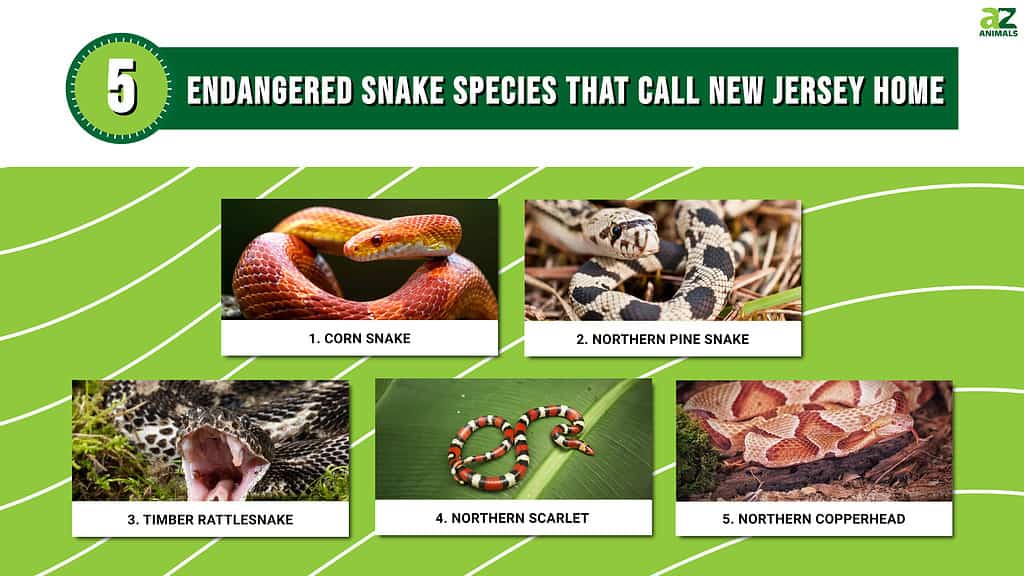
Did you know that almost two dozen species of snakes live in New Jersey, some of which can be found in the cities and urban areas? Living among 22 species of the most unwelcome creatures isn’t the news you’d be hoping to hear. The good news, however, is only two of these species are venomous. So, most snakes you’ll encounter in New Jersey are harmless. The bad news is some of these snakes are now endangered. This article discusses some of the endangered snake species in New Jersey that need to be protected and conserved.
1. Corn Snake
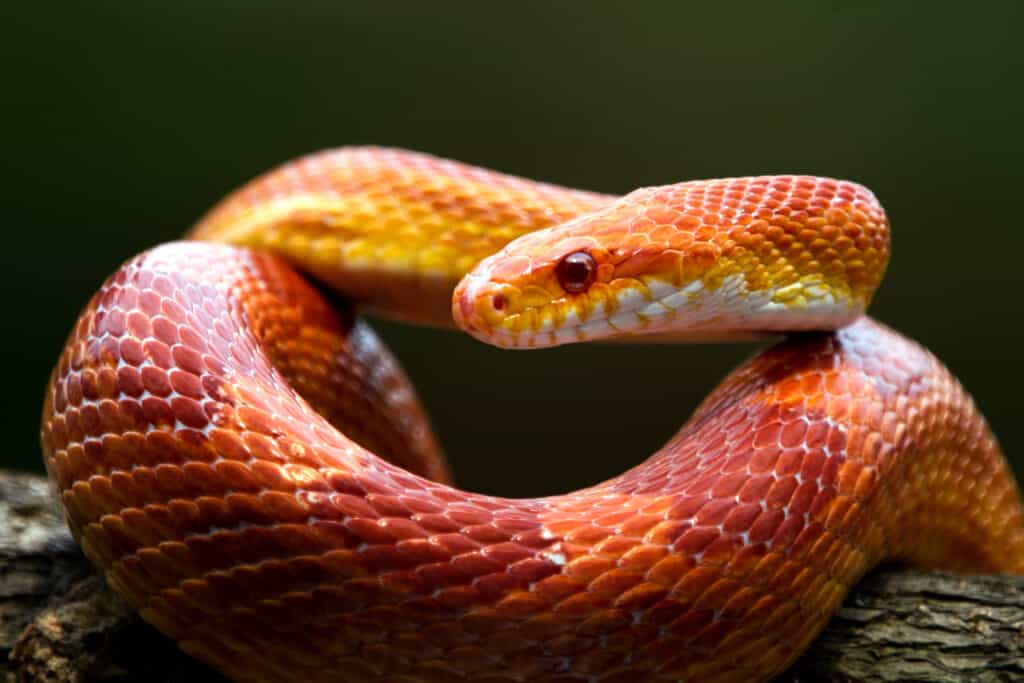
Corn snakes are often mistaken for copperheads.
©Kurit afshen/Shutterstock.com
The corn snake superficially resembles the venomous copperhead, and this mistaken identity often leads to its death when humans find it. In reality, it’s harmless to humans because it doesn’t have a functional venom. Unfortunately, the snake ends up on the list of endangered snake species in New Jersey because of this mistaken identity. You can distinguish it from the copperhead snake through its bright color, lack of heat-sensing pits, round pupils, and slender build. Corn snake kills their prey by constricting them. One of the benefits of this snake to humans is that it helps to control the population of wild rodent pests spreading diseases and damaging crops.
The adult corn snake can grow as long as two to six inches. It lives as old as 10 to 15 years in the wild but lives significantly longer in captivity. The oldest one on record lived for 32 years and three months.
This snake species is found in the Pine Barrens of New Jersey, where it’s considered a state-endangered species. Corn snake lives in sandy forest areas, especially pine-oak forests with a low brush understory. You may find it in railroad ties, hollow logs, under logs and boards, and old building foundations. Locally, it is nick-named red rat snake, with varying colors, including orange, brown, and gray. The back length is covered with orange, brown, or red blotches. However, some individuals may have stripes instead of blotches. Its scales are weakly keeled, and it lays five to 18 eggs in July or August, which hatch in late August to September.
2. Northern Pine Snake
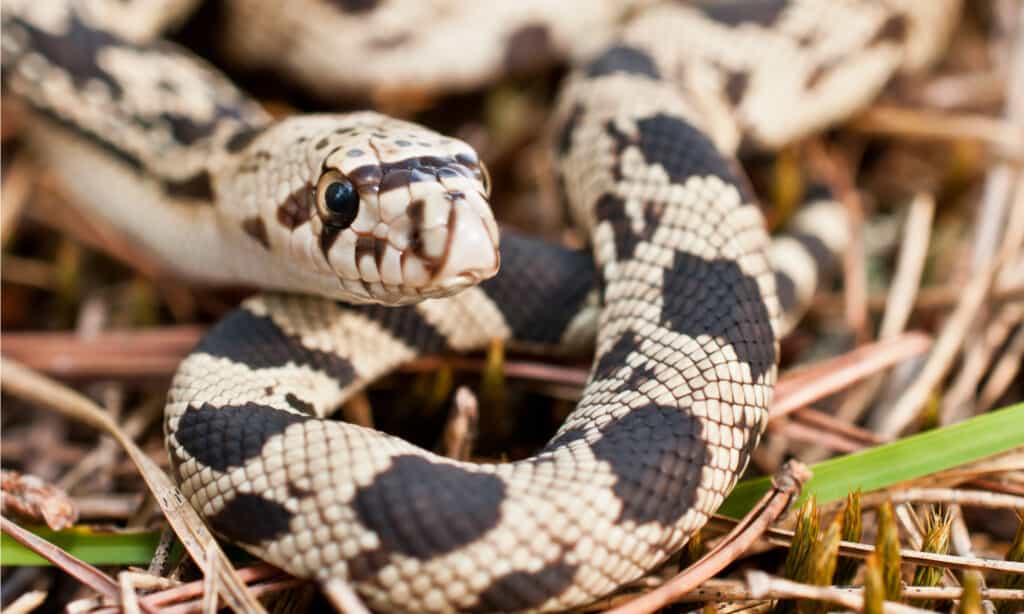
The northern pine snake is found in New Jersey’s Pine Barrens.
©Jay Ondreicka/Shutterstock.com
Northern pine snake is a nonvenomous snake endemic to the east of the United States, with three valid subspecies. This harmless snake grows long (between 48 and 90 inches long, including the tail) and has a powerful build. It has a small, slightly pointed head with enlarged rostral scales and four visible prefrontal scales.
The color pattern is gray, white, or a light ground color covered with brown, reddish-brown, or black blotches. The northern pine snake is one of the snake species found in New Jersey’s Pine Barrens and is considered a state-threatened species. It lives in sandy habitat due to its behavior of burrowing underground to lay eggs and find shelter. The blotches on this large snake are usually defined better towards the tail. When defending itself, it tends to be very vigorous, especially when it feels threatened. If handled, it can inflict pain with its bite, even though it’s non-venomous.
While it can climb trees and does this steadily, it spends a lot of time burrowing into sand for shelter. It lays its eggs in June and hatches them in August. Newly-hatched northern pine snakes typically measure 15 to 18 inches.
3. Timber Rattlesnake
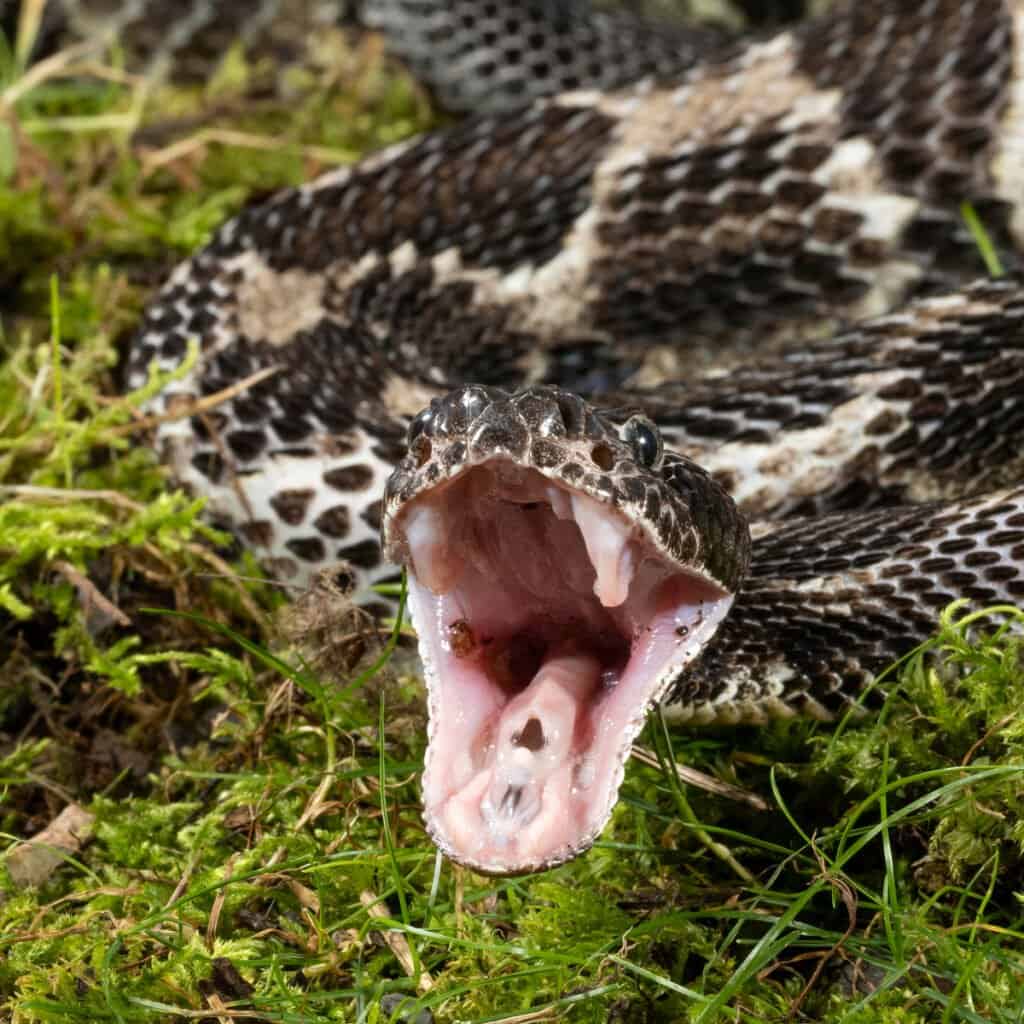
Timber
rattlesnakes
are endangered in New Jersey.
©Joe McDonald/Shutterstock.com
The timber rattlesnake (or banded rattlesnake or canebrake rattlesnake) is the only rattlesnake species in New Jersey and the Northeastern United States. However, it is one of the endangered species in New Jersey. The adult of this species can grow up to 36 to 60 inches, but most measure less than 45 inches, with weight ranging from 1.1 to 3.3 pounds.
The timber rattlesnake is considered a state-endangered snake species, with only three populations remaining in the northern region of New Jersey. They’re found along the Kittatinny Ridge, within the Pine Barrens in Southern New Jersey and the Highlands region.
In Northern New Jersey, it’s found in wooded and rocky areas, hunting in dense and open forests. While in Southern New Jersey, it inhabits pine-oak forests and swamps, hunting in dense and open forests and occasionally basking on dirt roads.
It has two varying color phases. The first is the yellow phase, where the ground color is brown to yellow with dark brown or black jagged V-shaped blotches towards the head. The second phase is the black phase. In this phase, it retains the same pattern as the yellow phase. However, the pattern is invisible because the dark-to-dark-brown ground color obscures it.
The last inches of the adult’s tail is dark brown or solid black, with an unmarked head. Some of these species may be fully black, but they all have keeled scales. Although they’re venomous, there has been no report of timber rattlesnakes killing anyone in New Jersey with their bite. In fact, the only reported bite incidents are those handling it. When threatened, it defends itself with its bite, so you should keep your distance. It births six to 10 young ones between late August and mid-September. As it’s a highly endangered species, all sightings should be reported to appropriate authorities.
4. Northern Scarlet
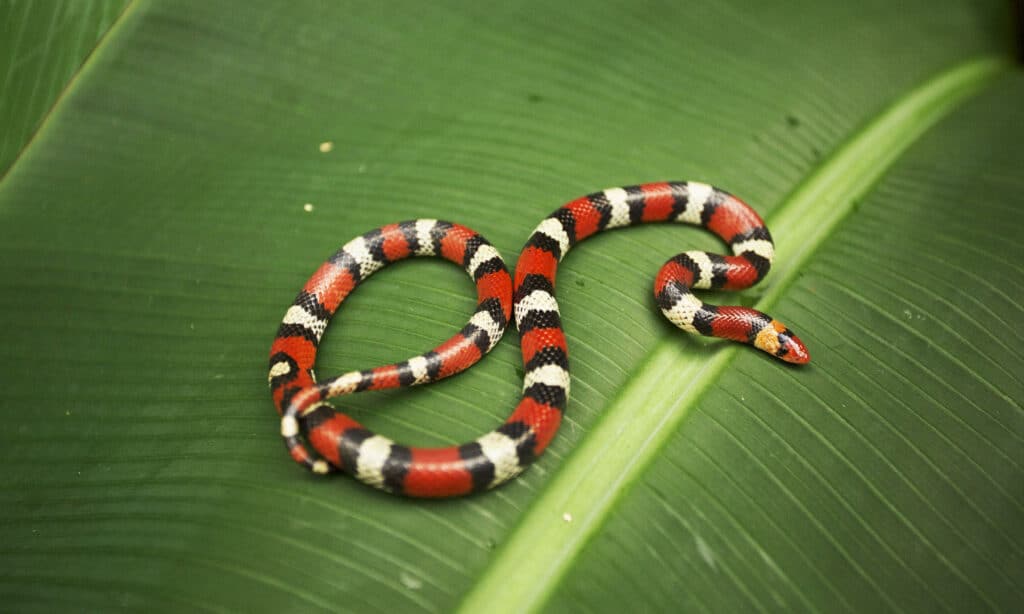
Northern scarlet snakes are uncommon in New Jersey.
©Fine Art Photos/Shutterstock.com
The northern scarlet snake is a nonvenomous snake native to the Eastern United States. This relatively small snake grows to only 14 to 26 inches as an adult. It has a dorsal pattern with a light gray ground color and yellow, white, or black blotches down the back. The belly is a uniform white or light gray color, with the dorsal blotches extending down the sides of the body, appearing like rings or bands. Because of this appearance, people often confuse this snake with sympatric species, like the harmless scarlet king snake or venomous coral snakes.
This snake is quite uncommon in New Jersey. It lives in sandy soils, mostly hiding under debris, logs, or board. But you can also find it near damp woodlands. Although the northern scarlet snake has a semblance with the venomous coral snake, it is not venomous. Black and creamy (or yellow) interspaces border the red bands on its body, keeping the red bands from extending around it. The scales are smooth, and they rarely come out except at night.
5. Northern Copperhead
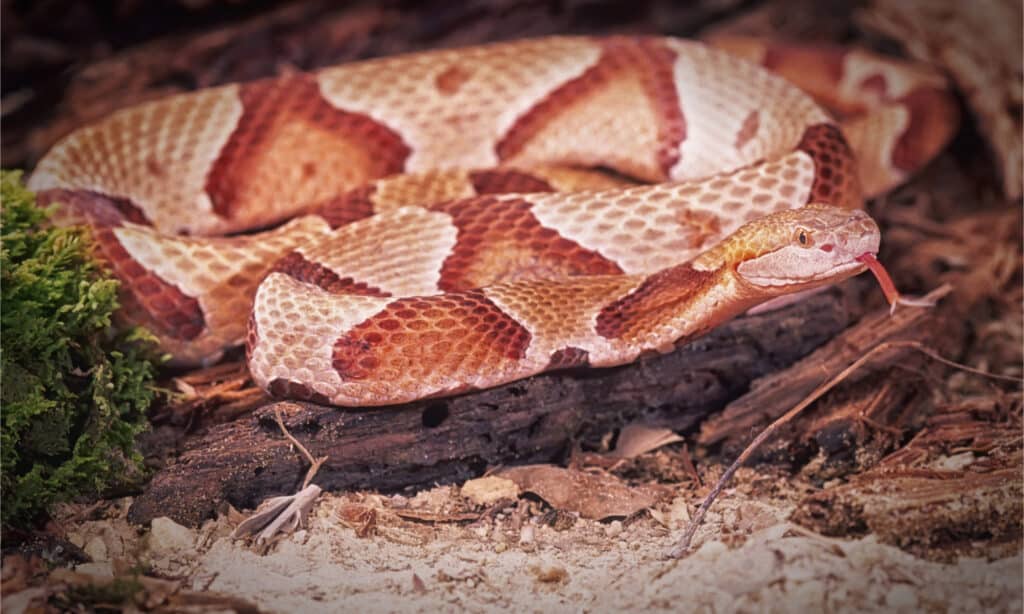
Northern copperheads are species of special concern in New Jersey.
©outdoorsman/Shutterstock.com
The northern copperhead is another of the two venomous snakes in New Jersey (the other being the timber rattlesnake). This snake is a species of concern in New Jersey. This uncommon snake lives in the northern region of New Jersey, extending south towards the Somerset counties and Sourlands of Hunterdon. The range also extends to localized areas in the north.
The length of the northern copperhead snake ranges from 22 to 53 inches. It lives in woodlands, farmlands, berry thickets, old mulch piles, and rocky fields. This snake species has two shades of copper or reddish brown. The light background color and the dark pattern form an hourglass shape with narrow bands on the back and wide bands on the sides. The tail of young copperhead snakes has yellow tips, which they use to lure their prey.
Although this snake is venomous, there has been no report of anyone dying from a copperhead snake bite in New Jersey. The snake does not actively attack people, but it’ll defend itself if it feels threatened, so it’s better to keep your distance. It births between six and 17 young reptiles between mid-August and early October.
Conclusion
New Jersey is home to several snake species, and only two are venomous. The bigger issue isn’t determining which ones aren’t venomous but conserving the already endangered ones. Everyone has a part to play in keeping these endangered snake species around.
Summary Of 5 Endangered Snake Species That Call New Jersey Home
| # | Snake | NJ State Listing (Not Federal) |
|---|---|---|
| 1 | Corn Snake | Endangered |
| 2 | Northern Pine Snake | Threatened |
| 3 | Timber Rattlesnake | Endangered |
| 4 | Northern Scarlet | Endangered |
| 5 | Northern Copperhead | Endangered |
Other Endangered Animals In New Jersey
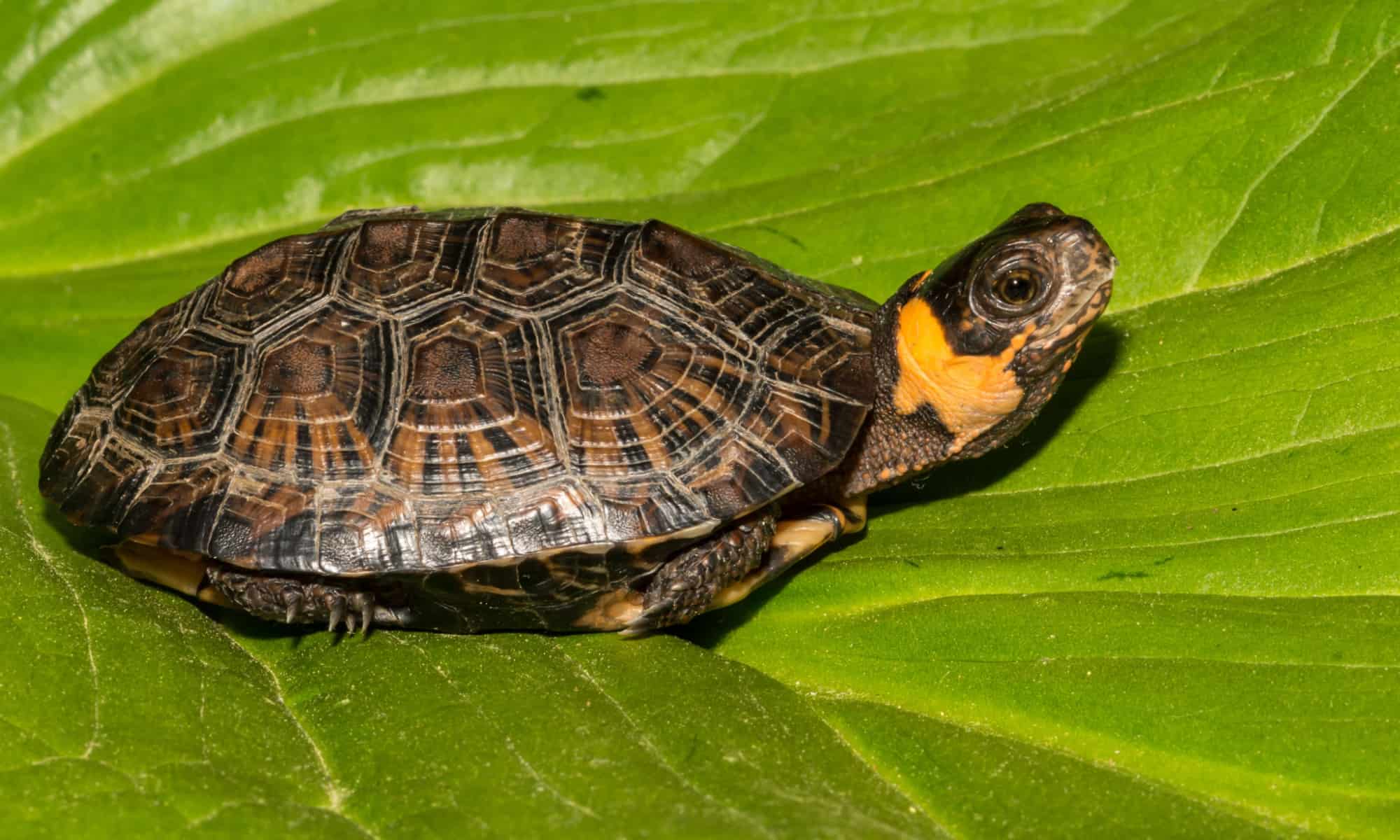
The bog turtle is the official state turtle of New Jersey.
©Jay Ondreicka/Shutterstock.com
New Jersey’s official state turtle is the Bog turtle, a reptile that walks at the “fast” speed of 0.25 miles per hour. Due to habitation loss because of over-development, pollution, and invasive species, this turtle is one of the 52 endangered species in the state. Listed by New Jersey in 1974 as endangered, the bog turtle was included on the federal list of threatened species in 1997. They are one of the smallest North American turtles, only reaching sizes of about 0.5 to 2 pounds and lengths of 5 to 6 inches but if given the right environment, can live a long life.

Blue Whales are the largest and one of the rarest animals in the world.
©Andrew Sutton/Shutterstock.com
Not only is it the largest but the Blue Whale is also one of the rarest animals in the world. Weighing 400,000 pounds (200 tons) and reaching almost up to 100 feet in length, this endangered behemoth is a baleen whale and has baleen plates rather than teeth that act as filters that sieve prey from the seawater. Baleen whales are also slow swimmers and unlike toothed whales, have two blowholes rather than one, which gives them more efficient access to oxygen that is essential to support their enormous bodies. Due to its conservation status, as well as 5 other whales, the blue whale was added to the New Jersey endangered species list in the wake of the enactment of the New Jersey Endangered and Nongame Species Conservation Act in 1973.
The photo featured at the top of this post is © Dennis Riabchenko/Shutterstock.com
Discover the "Monster" Snake 5X Bigger than an Anaconda
Every day A-Z Animals sends out some of the most incredible facts in the world from our free newsletter. Want to discover the 10 most beautiful snakes in the world, a "snake island" where you're never more than 3 feet from danger, or a "monster" snake 5X larger than an anaconda? Then sign up right now and you'll start receiving our daily newsletter absolutely free.
Thank you for reading! Have some feedback for us? Contact the AZ Animals editorial team.






